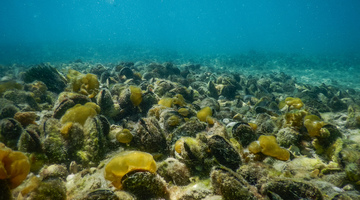University of Waikato Professor Conrad Pilditch, part of the Sustainable Seas National Science Challenge, provides insight into marine environmental stressors – events that put pressure on ecosystem1 productivity and functions.
Jargon alert
Positive feedback
Aquatic2 ecosystems3 are often able to quickly recycle nutrients4 and minerals. This resilience allows them to cope with disturbances.
Ecosystem goods and services
Beneficial services freely provided by nature. For example, shellfish are sources of kaimoana5 and they filter seawater, removing sediment6 and other impurities.
Transcript
Professor Conrad Pilditch
These stressors that are occurring in the environment can be point source stressors – such as we had when the Rena went down, an isolated case. But more often than not, they are occurring over multiple scales and are often cumulative7 in their effects. That means they accumulate through time and through space. Some of these stressors we may not think of, such as the increasing sedimentation8 into our coastal waters. You can see the effects of rain storms at a spatial scale that occurs in the Cook Strait, Taranaki Bight, Tasman Seas/Golden Bay picture.
These stressors are occurring locally. They can occur and we may have some control over them but also, we need to put that in a broader scale context and think about other stressors that are interacting with our hidden infrastructure that may impact upon it. That includes such things as climate change9, we are in a warming world, and increasingly, due to increasing atmospheric CO2, a more acidified oceanic world.
These stressors are not occurring in isolation. They are interacting with each other and impacting upon the system from which we derive these goods and benefits from. It may seem that the system is absorbing and has the capacity to carry on as normal in the face of these increasing stressors but that occurs because of the positive feedbacks10 between the organisms that are interacting with the environment, allows them to maintain themselves in a certain state. But as we push the system, as we nudge it along, as we increase our activities in the catchment11, as we increase the intensification of fishing or harvesting in our coastal waters, the system becomes vulnerable to change. Now the point is, we don’t necessarily see that change coming so a relatively small change in stressor can have catastrophic effects. It’s illustrated quite nicely in this little diagram here with the gold fish leaving the small pond to this rather big pond. That can generate surprise. That can generate big changes in how the system functions and how the system is wired and consequently, the delivery of those goods and services to humanity, that loss of those cultural and spiritual values as the system changes.
Acknowledgements
The Science Learning Hub acknowledges the contribution of the Sustainable Seas National Science Challenge and Professor Conrad Pilditch.
Footage supplied by the Sustainable Seas National Science Challenge.


